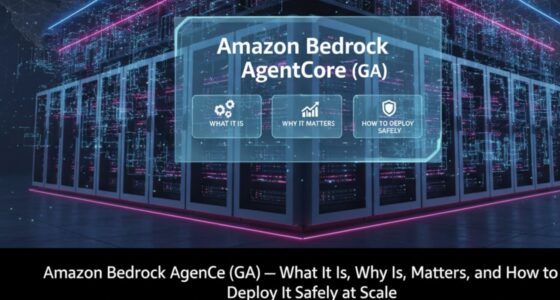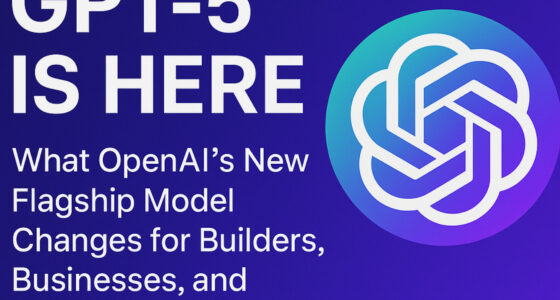As Edge AI grows, it shifts cloud dynamics by enabling on-device processing, which reduces latency and enhances data privacy. You can expect faster responses critical for autonomous systems and remote operations, even without internet. This also cuts down on bandwidth and cloud costs while improving security by keeping sensitive data local. These changes are shaping a future where devices handle more tasks independently—stick with us to discover how this evolution continues.
Key Takeaways
- Edge AI enables real-time processing, reducing reliance on cloud-based data transmission and decreasing latency.
- On-device AI enhances data privacy and security by limiting sensitive information transfer to the cloud.
- Local AI processing decreases bandwidth costs and network congestion, optimizing operational efficiency.
- Edge AI supports offline and resilient operations in remote or bandwidth-limited environments.
- Increased adoption of on-device AI may shift cloud infrastructure demands toward more scalable, management-focused services.
The Impact of Reduced Latency on Critical Applications

Have you ever wondered how some applications can respond instantly in high-stakes situations? That’s the power of reduced latency, driven by Edge AI. When data is processed locally on your device, responses happen in milliseconds, critical for autonomous vehicles, industrial robots, and AR/VR systems. Cloud AI, however, suffers delays because data must travel to remote servers, introducing unavoidable lag. With Edge AI, decisions are made at the source, enabling real-time analytics and immediate action. This rapid response capability is essential when delays could mean safety risks or costly errors. By minimizing latency, Edge AI transforms how critical applications operate, making them faster, more reliable, and better suited for environments where every millisecond counts. Utilizing network optimization techniques further enhances these benefits by reducing data transmission times even more.
Enhancing Data Privacy and Security Through Local Processing

Building on the benefits of low latency, the focus now shifts to how Edge AI enhances data privacy and security. By processing data locally, you reduce the risk of sensitive information exposure during transmission. This approach helps you comply more easily with regulations like GDPR, as less data needs to cross networks. Additionally, local storage minimizes the chance of breaches in transit or at centralized servers. Consider these key points:
Processing data locally enhances privacy, reduces transmission risks, and simplifies compliance with regulations like GDPR.
- Sensitive data remains on-device, limiting exposure.
- Reduced data transfer lowers interception risks.
- Local processing helps meet privacy regulations effortlessly.
- Fewer cloud interactions decrease vulnerability to cyberattacks.
Offline Capabilities and the Future of Remote Operations

Offline capabilities let you keep operations running smoothly even without internet access, which is essential for remote sites. This independence guarantees your systems stay functional and autonomous, regardless of connectivity issues. As remote operations grow, embracing offline functionality becomes key to maintaining efficiency and resilience. Additionally, implementing privacy policies ensures user data is protected even when offline, maintaining trust and compliance.
Offline Functionality Benefits
In remote and challenging environments, the ability of edge AI devices to operate without relying on constant internet connectivity offers significant advantages. You can maintain critical functions even when connectivity is spotty or unavailable. This independence guarantees continuous data processing, decision-making, and system operation. Here are some key benefits:
- Uninterrupted Operations: Devices keep functioning without delays caused by network issues.
- Enhanced Reliability: Less reliance on external infrastructure makes systems more resilient.
- Cost Savings: Reduced need for constant data transmission cuts operational expenses.
- Data Privacy: Sensitive information stays local, minimizing exposure risks.
- Supporting Home Automation integration, offline capabilities allow smart systems to operate smoothly without internet interruptions.
These benefits enable industries like mining, agriculture, and maritime to operate efficiently and securely, regardless of connectivity constraints. Offline functionality empowers you to sustain productivity and reliability in the most challenging environments.
Remote Site Autonomy
Remote site autonomy is transforming how industries operate in isolated environments by enabling devices to function independently of constant internet connectivity. You can now deploy AI-powered systems in remote areas like mines, farms, or offshore platforms, where stable connections are rare. These devices process data locally, making real-time decisions without waiting for cloud input. This independence reduces downtime, enhances safety, and improves efficiency. Here’s how it works:
| Aspect | Benefit | Example |
|---|---|---|
| Offline Operation | Continuous functionality | Mining equipment in caves |
| Local Data Storage | Minimized data transfer | Agricultural sensors |
| Autonomous Decision | Immediate response | Maritime navigation systems |
With remote site autonomy, industries gain resilience and operational continuity in the most challenging environments. Creating a resilient infrastructure is essential for maximizing the benefits of on-device AI in remote settings.
Connectivity Independence
Connectivity independence is reshaping how industries operate in areas with limited or unstable internet access, empowering devices to perform reliably without constant online support. This shift allows remote operations to continue seamlessly, even when connectivity drops. With offline capabilities, you can process data locally, ensuring real-time decision-making and reducing delays. Consider these key advantages:
- Enhanced Reliability: Devices function continuously without internet, vital for safety-critical tasks.
- Operational Continuity: Remote sites stay productive regardless of network stability.
- Data Privacy: Sensitive information stays local, lowering breach risks.
- Cost Efficiency: Reduced dependence on high-bandwidth connectivity cuts operational expenses.
Scalability Challenges and Opportunities in Edge AI Deployment

Deploying edge AI at scale presents significant challenges because each device typically has limited processing power, storage, and energy resources. To handle complex models, you often need hardware upgrades or optimized algorithms, which can increase costs and complexity. Scaling across thousands of devices demands efficient management, updates, and consistent performance, often requiring specialized tools. You also face difficulties in balancing local processing with centralized control, especially when dealing with hardware heterogeneity. However, opportunities exist through advancements in lightweight AI models, edge-specific hardware, and federated learning techniques. These innovations enable you to deploy smarter, more autonomous devices that operate effectively with constrained resources, paving the way for broader, more resilient edge networks. Overcoming these challenges enable new possibilities for real-time, privacy-preserving AI applications. Relationships – Personality Test can also be used to assess how well a team adapts to these evolving deployment strategies.
Cost and Bandwidth Efficiency: Reimagining Data Transmission

With edge AI, you only transmit essential insights, drastically cutting down on bandwidth use and operational costs. Instead of sending all raw data to the cloud, it processes locally, saving resources and reducing expenses. This approach not only boosts network efficiency but also makes large-scale IoT deployments more economical and manageable. Additionally, employing cost-effective strategies like mediation and online resource utilization can further optimize asset management in broader technological applications.
Reduced Data Transmission Needs
Edge AI markedly reduces data transmission needs by processing information locally and only sending essential insights or alerts to the cloud. This approach minimizes bandwidth consumption and cuts operational costs. You avoid sending raw data, which can be massive, and instead transmit concise summaries or alerts, streamlining communication. Here’s how it benefits you: 1. Lower bandwidth usage, reducing network strain and costs. 2. Faster response times by eliminating delays caused by data transfer. 3. Decreased reliance on internet stability, enabling offline operation. 4. Reduced storage and processing demands in the cloud, saving money. Additionally, advancements in projector technology can enhance the visual quality of your home setup.
Lower Operational Expenses
Reimagining data transmission with lower operational expenses hinges on optimizing how data is handled at the source. By processing data locally through Edge AI, you send only essential insights or alerts to the cloud, drastically reducing bandwidth use. This approach cuts operational costs associated with transmitting vast amounts of raw data, especially in large-scale IoT deployments. Less data sent means lower storage and cloud processing expenses, helping you save money. Moreover, local processing minimizes the need for high-capacity internet connections, reducing infrastructure costs. Industries like manufacturing, surveillance, and agriculture benefit considerably, as they can operate more efficiently without constantly relying on expensive, high-bandwidth networks. Incorporating tableware considerations into data presentation can enhance clarity and user engagement. Overall, Edge AI streamlines operations by making data transmission leaner and more cost-effective.
Enhanced Network Efficiency
By processing data locally, Edge AI substantially improves network efficiency by reducing the volume of information transmitted over the internet. This minimizes bandwidth use and lowers operational costs. Instead of sending raw data, only essential insights or alerts are communicated, streamlining data flow. Here’s how it enhances efficiency:
- Markedly reduces bandwidth consumption, saving costs.
- Minimizes data transfer, alleviating network congestion.
- Decreases reliance on high-speed internet, enabling remote operations.
- Lowers cloud storage expenses by filtering data at the source.
- Processing at the edge enables faster, real-time responses, further enhancing operational efficiency.
This approach not only optimizes network resources but also accelerates response times, especially for time-sensitive applications. As a result, you benefit from faster decision-making processes and more reliable connectivity, making your operations more agile and cost-effective.
Managing and Updating Decentralized Edge Devices

Managing and updating decentralized edge devices presents unique challenges because their distributed nature makes centralized control more complex. You need reliable methods for deploying firmware and AI model updates across numerous devices, often in remote or inaccessible locations. Over-the-air (OTA) updates are essential but can be inconsistent due to network variability or device limitations. Ensuring security during updates is crucial to prevent unauthorized modifications. You also face the risk of bricking devices if updates fail mid-process, which complicates maintenance. Regularly monitoring device health and performance becomes vital to identify issues early. Robust security protocols are necessary to safeguard against potential cyber threats during the update process. Balancing timely updates with minimal disruption requires carefully planned update schedules. Ultimately, effective management demands scalable solutions that combine automated deployment, security protocols, and real-time diagnostics.
Hybrid Models: Combining Edge and Cloud for Optimal Performance

Combining edge and cloud AI leverages the strengths of both approaches to deliver peak performance. This hybrid model balances real-time responsiveness with scalable processing power. Here’s how you can optimize this synergy:
- Deploy critical, time-sensitive tasks on edge devices to ensure minimal latency and instant decision-making.
- Use the cloud for heavy analytics, model training, and data storage, reducing local hardware demands.
- Synchronize data periodically between edge and cloud to maintain accuracy without overloading networks.
- Implement management tools that coordinate updates, security, and monitoring across both layers, ensuring consistency.
This approach enables you to handle diverse operational needs efficiently, offering the agility of edge processing and the robustness of cloud infrastructure—maximizing performance while controlling costs.
Shifting Power Dynamics Between Data Centers and End Devices

As edge AI solutions become more widespread, the balance of power shifts from centralized data centers toward the end devices themselves. You now have the ability to process data locally, reducing reliance on cloud infrastructure. This shift means devices can make quick decisions without waiting for server responses, especially in time-critical applications like autonomous vehicles or industrial automation. You gain greater control over data privacy, since sensitive information stays on the device, minimizing exposure risks. Additionally, devices can operate effectively with limited or no internet connectivity, expanding possibilities in remote areas. However, this shift challenges scalability and management, requiring hardware upgrades and more complex updates. Overall, the power dynamic favors more autonomous, efficient devices, transforming how data is generated, processed, and controlled at the edge.
Future Trends and Innovations in Edge AI Technology

Future trends in Edge AI technology point toward greater integration of advanced hardware and smarter algorithms that enable devices to learn and adapt locally. You’ll see more powerful processors, specialized chips, and energy-efficient designs boosting device capabilities. Additionally, innovations in federated learning will allow models to improve across distributed devices without sharing raw data. Here are key trends to watch:
- Edge AI chips: Development of ultra-efficient, high-performance processors tailored for real-time processing.
- Self-learning devices: AI models that adapt continuously through on-device training, reducing reliance on cloud updates.
- Hybrid architectures: Combining edge and cloud AI to optimize performance, scalability, and privacy.
- Edge AI ecosystems: Growing platforms enabling seamless deployment, management, and updates across diverse devices.
These innovations will shape a future where edge devices become smarter, more autonomous, and more secure.
Frequently Asked Questions
How Does Edge AI Handle Software Updates Across Numerous Devices?
You handle software updates across many edge devices through over-the-air (OTA) mechanisms or device-by-device updates. While cloud systems enable centralized management, updating each device individually can be complex and inconsistent. You need robust management tools to deploy updates reliably, monitor progress, and guarantee devices stay current. This process requires careful planning to minimize disruptions and ensure all devices operate with the latest software versions.
What Are the Main Hardware Limitations for Deploying Large AI Models on Edge Devices?
You face hardware limits like restricted processing power, memory, and storage when deploying large AI models on edge devices. Unlike cloud servers with vast resources, these devices struggle with high computational demands and limited RAM, making complex models difficult to run efficiently. This means you often have to optimize, simplify, or partition models, balancing performance with hardware constraints to achieve real-time, on-device AI functionality.
How Do Regulatory Standards Influence Local Data Processing and Storage at the Edge?
Regulatory standards push you to process and store data locally at the edge to guarantee privacy, security, and compliance, like GDPR. You’ll need to implement strict controls, encryption, and audit trails to meet these rules. This limits data transfer, reduces exposure, and helps avoid penalties. However, it may also increase complexity and costs, requiring you to adapt your hardware, software, and management practices to stay compliant with evolving regulations.
Can Edge AI Effectively Replace Cloud AI in Large-Scale Enterprise Environments?
Think of replacing cloud AI in large enterprises like upgrading from a fleet of cars to a network of bikes. Edge AI can handle critical tasks locally, offering low latency, enhanced privacy, and offline operation. However, it’s restricted by hardware and scalability. For complex, large-scale operations, combining both ensures you get the best of immediate responsiveness and powerful analytics, making a hybrid approach your most effective strategy.
What Security Challenges Are Unique to Managing Decentralized Edge AI Systems?
You face unique security challenges managing decentralized edge AI systems. Since each device stores and processes data locally, you must guarantee consistent security protocols across all units, which can be complex. You also need to protect against physical tampering, unauthorized access, and firmware vulnerabilities. Regular updates and monitoring become more difficult, increasing the risk of security breaches. Balancing data privacy, device integrity, and operational continuity is essential for effective edge AI management.
Conclusion
Imagine your smartphone as a tiny control tower, making split-second decisions without waiting for the cloud. Edge AI is transforming how we process data, much like a local shop that serves customers faster than a distant warehouse. As this technology grows, it’s like a tide rising—lifting your devices’ capabilities while reshaping cloud dynamics. Embrace this shift, because the future of AI is happening right at your fingertips.









